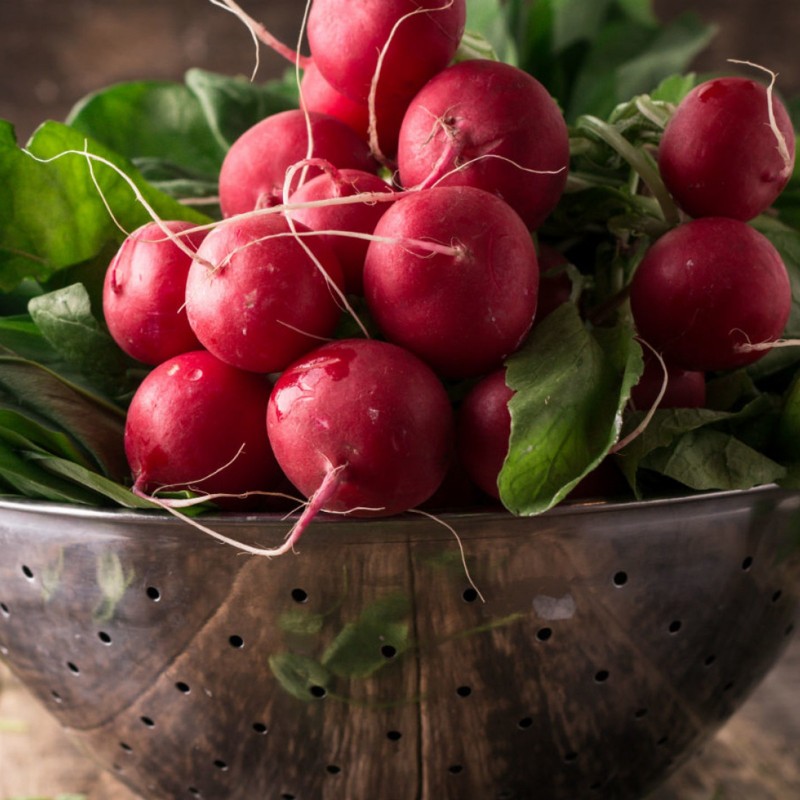





Rättika NON PLUS ULTRA Raphanus sativus var. sativus An early variety, Tarsty and juicy tubers are big and dark red. Use fresh with beer, bread, cheese or in salads. A really nice crop between main crops or to sow between lettuce or carrot plants. The seed needs 8-10 days to germinate.
Very tender and fine grained, rarely becoming hollow or pithy. Medium size and vivid scarlet colour. Fine forcing variety. Round. Forcing.
Rättika (Raphanus sativus, vissa varieteter) är en stor rotfrukt i familjen korsblommiga växter. Rättika kallas på svenska de odlade varieteterna av växten Raphanus sativus som har en stor rot (egentligen en uppsvälld stamknöl) som antingen är avlång eller rund. Mindre varieteter av samma art kallas på svenska rädisa.
Biologi och användning
Rättika är en tvåårig ört, och roten skördas under det första året. Skalet kan vara svart eller vitt, medan köttet alltid är vitt. Det är den uppsvällda stamknölen, strax ovanför den egentliga roten, som används i matlagningen. Smaken liknar rädisa och kommer liksom hos denna från växtens senapsoljor. Vitskaliga rättikor är mildare i smaken än rädisa, svartskaliga skarpare än rädisa.
Historik
Rättikan/rädisan är en av de äldsta kulturväxterna. Odling av rättika påbörjades möjligen först i Mindre Asien, och därifrån nådde den på 2000-talet f.Kr. till Egypten. Redan hos arbetarna vid pyramidbyggen ingick rättika i kosten. Via Grekland och Romarriket spreds odlingen västerut, och under senantiken spreds den till området norr om Alperna.
Norden finns rättika nämnd i läkeböcker i slutet av 1400-talet, och under 1500-talet vann den vidare spridning. Rättika finns beskriven i svensk text på 1500-talet. Odlingen i Sverige är av mindre skala, medan i Central- och Sydeuropa är en av de viktigare rotfrukterna.
Från Medelhavsområdet spreds rättika även österut och nådde bland annat Östasien. I Japan är daikon, en mild, vitskalig variant av rättika, en av de viktigaste rotfrukterna.
Datablad
Radishes are a hardy, easy-to-grow root vegetable that can be planted multiple times in a growing season.
Here’s how to plant and grow radishes in your garden!
Radish seeds can be planted in both the spring and the fall, but growth should be suspended in the height of summer when temperatures are typically too hot. (Hot temperatures may cause radishes to bolt, making them essentially useless.)
Otherwise, radishes are one of the easiest vegetables to grow.
Plant in a sunny spot. If radishes are planted in too much shade—or even where neighboring vegetable plants shade them—they will put all their energy into producing larger leaves.
Like carrots, radish plants are primarily grown for their roots. Though the soil needs to be rich in organic matter, it should not be compacted. If your soil is more clay-like, mix in some sand to loosen it and improve drainage.
If your soil isn’t rich in organic matter, incorporate a few inches of aged compost or all-purpose fertilizer (see packaging for amount) into the planting site as soon as the soil is workable.
Till your garden bed to remove any rocks or dirt clods before planting.
Practice three-year crop rotation. In other words, only plant radishes in the same spot every third year. This will help prevent diseases from affecting your crop.
For a spring planting, sow seeds 4–6 weeks before the average date of the last frost. See local frost dates here.
It’s best to plant radish seeds directly in the garden so as not to disturb their roots. Directly sow seeds outdoors 2 cm deep and 2,5 cm apart in rows 28 cm apart.
Plant another round of seeds every 10 days or so—while weather is still cool—for a continuous harvest of radishes in the late spring and early summer.
Plan on a fall planting. You can plant radishes later than any other root crop in late summer or early fall and still get a harvest. Sow seeds 4–6 weeks before the first fall frost.
Thin radishes to about 2 inches apart when the plants are a week old. Crowded plants do not grow well.
Consistent, even moisture is key. Keep soil evenly moist but not waterlogged. A drip irrigation system is a great way to achieve this.
Putting a thin layer of mulch around the radishes can help retain moisture in dry conditions.
Radishes will be ready to harvest quite rapidly, as soon as three weeks after planting for some varieties.
For most varieties, harvest when roots are approximately 2,5 cm in diameter at the soil surface. Pull one out and test it before harvesting the rest!
Do not leave radishes in the ground long after their mature stage; their condition will deteriorate quickly.
Cut the tops and the thin root tail off, wash the radishes, and dry them thoroughly. Store in plastic bags in the refrigerator.
Radish greens can be stored separately for up to three days.
Radish seeds have a fairly long shelf life. Don’t be afraid to plant radish seeds that are up to five years old. All may not germinate, but you’ll have plenty that will.

 Reviews (0)
Reviews (0)